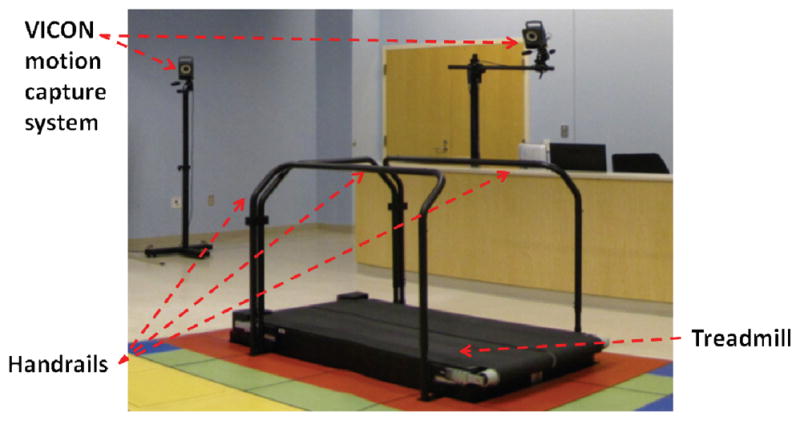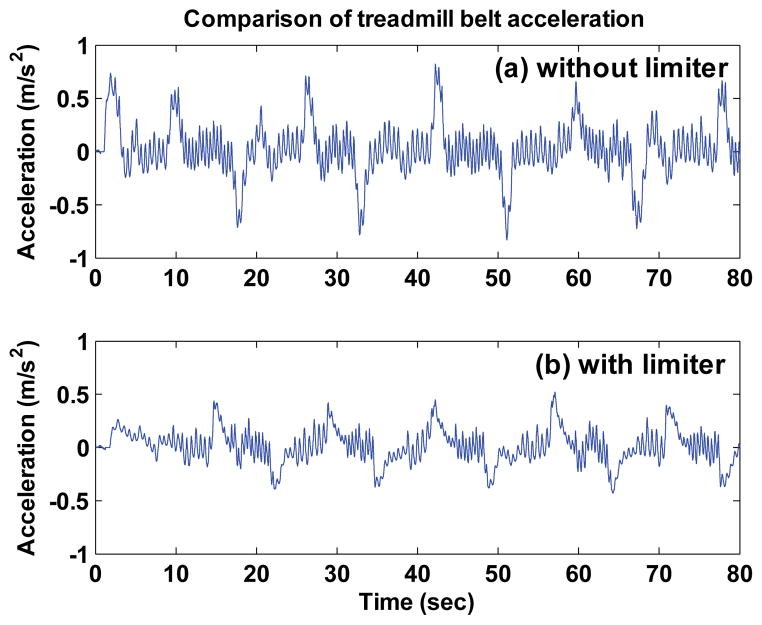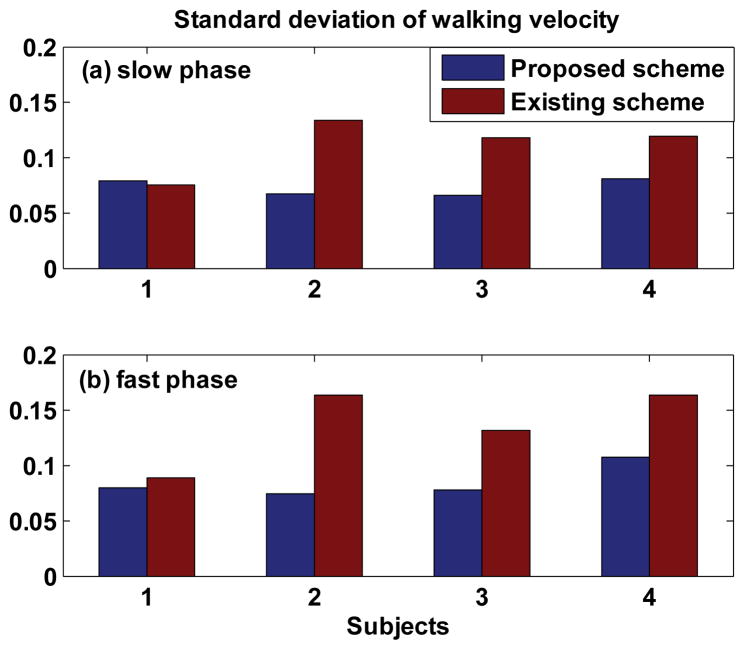Abstract
Treadmill-based locomotor training should simulate overground walking as closely as possible for optimal skill transfer. The constant speed of a standard treadmill encourages automaticity rather than engagement and fails to simulate the variable speeds encountered during real-world walking. To address this limitation, this paper proposes a user-driven treadmill velocity control scheme that allows the user to experience natural fluctuations in walking velocity with minimal unwanted inertial force due to acceleration/deceleration of the treadmill belt. A smart estimation limiter in the scheme effectively attenuates the inertial force during velocity changes. The proposed scheme requires measurement of pelvic and swing foot motions, and is developed for a treadmill of typical belt length (1.5 m). The proposed scheme is quantitatively evaluated here with four healthy subjects by comparing it with the most advanced control scheme identified in the literature.
I. Introduction
Treadmill-based locomotor training (TBLT) has become a common rehabilitation method for patients with locomotor disorders [1–3]. TBLT provides a safe and fairly compact environment for improving lower extremity coordination and control during walking.
It was reported that treadmill locomotion (TL) is very similar to overground locomotion (OL) in constant walking velocity [4]. Hence, most TBLT protocols have focused on gait rehabilitation using a constant walking velocity [1–3, 5]. Highly functioning patients accommodate and soon habituate to the treadmill speed, and the training becomes automatic requiring little conscious engagement. Consequently, the patients of the protocols might be less motivated.
To make TBLT more similar to OL, users should be free to change velocity instead of a forced accommodation to a fixed treadmill speed. However, when the treadmill belt accelerates, it applies a force to the user that would not be felt during natural OL [6] making the simulation of variable velocity challenging. The force due to accelerating belts is an unwanted and unnatural inertial force which does not exist in OL. It is known that the unwanted inertial force on treadmills causes users to use less energy [7]. This paper aims at developing a user-driven treadmill velocity controller with the following specific aims:
Users can naturally change walking velocity while the treadmill follows their intention of velocity change.
Unwanted inertial force due to acceleration/deceleration of the treadmill is minimized to better simulate OL.
Many user-driven velocity controllers in the literature focus on achieving the first aim. Proportional- derivative (PD) [8] and Proportional-integral-derivative (PID) position control schemes [9] adjust treadmill velocity by using pelvic motion feedback. Another study used ground reaction force and center-of-pressure measurements from an instrumented treadmill to adjust velocity [10]. It has been reported that swing foot velocities measured by motion capture systems can be utilized to estimate the walking velocity [11]. These attempts, however, do not consider the second aim, and thus fail to provide a solution to the inertial force.
One solution considered to address the second aim was to directly control the force by using a force-feedback device, such as a tether, which either pushes or pulls at the back of the user [6, 12]. However, it is hard to transfer forces from the tether to the user’s torso if the connection between the tether and the torso is not rigid enough [13]. On the other hand, TL becomes unnatural if the mechanism is rigid [14].
To our knowledge, the most advanced attempt that considers both aims was to avoid large accelerations of the treadmill belt by using a position controller and a feedforward compensator with an observer-based walking velocity estimator [14]. The control scheme reported in the literature was only verified with a custom-made treadmill with a long belt (6 m). If that control scheme is applied to smaller treadmill, users may feel large unwanted inertial forces due to noticeable accelerations of the shorter belt [14]. Moreover, the literature only reported the result of qualitative evaluation based on user surveys [14].
This paper proposes a user-driven treadmill velocity control scheme to achieve both aims. Our goal is to attenuate the unwanted inertial force on a treadmill with shorter and more typical belt length (1.5 m). Along with pelvic position feedback control, we propose a control scheme that utilizes an observer-based estimation with a smart estimation limiter for attenuating unwanted inertial force. The scheme does not use only pelvic motion but also swing foot motions for minimizing the inertial force. Through clinical experiment with four healthy subjects, the effects of the attenuated inertial force due to the proposed scheme are quantitatively evaluated.
II. User-driven Treadmill Control Scheme
A. Control law
A kinematic model of the treadmill/user system can be expressed as follows [14]:
| (1) |
where x denotes the user’s absolute pelvic position, ut the velocity of treadmill belt, and Vw denotes the user’s walking velocity.
Based on (1), a pelvic position feedback controller to achieve exponential stability is proposed as follows:
| (2) |
where ut denotes the velocity command of treadmill belt, ki > 0 (i=1~3) the gains, and xref the reference pelvic position.
Since the user’s walking velocity (Vw in (2)) cannot directly be measured, the following dynamic observer is applied for online estimation of the velocity [14]:
| (3) |
where λ denotes the internal state of the observer, β the observer gain, and Ṽw the user’s estimated walking velocity that is used to implement (2) instead of Vw.
The advantage of the observer-based estimation is not only to implement (2) without Vw but also to make the system partially insensitive to change in walking velocity. Since reducing the observer gain (β) makes the estimation of Vw slower, the velocity of the treadmill belt that is determined by (2) does not rapidly change according to Vw. Hence the observer-based estimation can contribute to reducing the inertial force in TL.
B. Smart estimation limiter
The proposed control law contains observer-based estimation for reducing the inertial force. Since [14] was able to use a treadmill with a long belt (6 m), the observer gain could be set to a small value. However, the gain should be tuned to a larger value as the treadmill length becomes shorter, resulting in greater accelerations. Fig. 1a shows an experimental result of the controller in [14] which was best-tuned for the shorter treadmill when the user changed walking velocity between 0.9 m/s and 1.5 m/s. It means that the inertial force felt by the user is noticeable during acceleration. Since the direction of inertial force is the same as that of the acceleration/deceleration, the user may not only use less energy but also experience difficulty in controlling walking velocity.
Figure 1.
Comparison of treadmill belt acceleration: (a) without limiter, (b) with limiter.
This inertia force is due to the rapid change of Ṽw from the estimation in (3). To reduce the unwanted inertial force, we implemented an algorithm that temporarily limits updating of treadmill velocity at the time the user accelerates/decelerates. Since Ṽw converges exponentially to Vw, Ṽw, changes faster in the earlier stage of the acceleration. Therefore, it is important to detect the beginning of acceleration as early as possible and to apply the velocity estimation limiter.
For earlier detection of the acceleration phase, quicker estimation of walking velocity is needed, and we employed a novel walking velocity estimation method by using swing foot velocity [11]. By measuring the maximum swing foot velocity, the walking velocity is estimated at the first half of swing phase as
| (4) |
where vm denotes for the maximum swing foot velocity measured by the motion capture system [11].
Equation (4) is less accurate than (3) because (4) is based on the assumption of swing velocity profile [11]. The estimation by using (4) has a benefit in terms of earlier detection of acceleration. The maximum swing foot velocity (vm) can be obtained during the first half of the swing phase, which allows the estimation to be completed within the first half of the step period. This maximum swing foot velocity is updated at every swing phase (or step), and if there is significant increase/decrease in vm, it is considered as acceleration/deceleration.
After detecting the acceleration/deceleration phase, the estimated velocity from (3) is limited based on the following limiter:
| (5) |
where Ṽw,i and Ti denotes the estimated velocity and the time at the beginning of the acceleration/deceleration phase, respectively, and clm denotes the maximum amount of velocity that can be increased/decreased during the unit time. clm is set to a smaller value than the actual acceleration of walking so the belts accelerate slower. According to the estimated velocity due to (4), this paper opts for four degrees of clm: 0.1 and 0.2 m/s2 for slow and fast acceleration; −0.1 and −0.2 m/s2 for slow and fast deceleration. The smart estimation limiter works for a short period of time at the very beginning of the acceleration/deceleration phase until the output of (5), V̂w (t), converges to the output of observer (3) within the predefined bound. By limiting the belt acceleration (Fig. 1b), the users feel a reduced amount of unwanted inertial force.
III. Methods
A. Experimental design
Since the proposed control scheme is to attenuate the inertial force, it could make variable-velocity TL more comfortable and more similar to OL. In order to evaluate the performance of the scheme quantitatively, we chose two outcome measures: 1) the amount of treadmill belt acceleration/deceleration and 2) the standard deviation (SD) of the user’s walking velocity under the period with constant desired velocity. The first is a direct index to show the performance of the scheme because it is proportional to the inertial force. In contrast to qualitative and subjective user surveys, the second measure quantitatively represents how comfortably the user can control walking velocity in TL with the control scheme.
For the evaluation the proposed scheme is compared with the most advanced scheme in [14]. The TLs using both schemes were performed on a treadmill with 1.5 m belt length (Bertec Co., Columbus OH, USA) (Fig. 2) to overcome the limitation that the existing scheme was only tested on a custom treadmill with long belt (6 m) [14]. Velocity commands to the treadmill were provided through a TCP/IP connection by a C++ program that sent out the commands at 120 Hz. For safety, hand rails were installed on the front and two sides of the treadmill (Fig. 2).
Figure 2.

Experimental setup
The user’s pelvic and foot motions, which are used to implement the proposed scheme, were captured by a VICON motion capture system consisting of 12 infrared cameras (VICON Inc., Denver CO, USA) (Fig. 2). Two markers were placed on the posterior superior iliac spine for pelvis tracking and two markers were attached to the lateral side of each foot at a distance of 2 cm below the ankle joint. The positions of the markers were captured at a sampling rate of 120 Hz. Based on the position, the velocity and the acceleration were obtained by numerical differentiation that adopt a fourth-order Butterworth low pass filter with 10 Hz cutoff frequency.
B. Protocol
Four healthy subjects (2 male and 2 female) participated in this study. All participants signed informed consent approved by NIH IRB prior to the experiment.
Each subject’s self-selected walking velocity was measured as they walked overground in order to determine their slow (75% of their self-selected walking velocity) and fast walking velocity (125% of their self-selected walking velocity). Next, the subjects walked on the treadmill under two optimally-tuned control schemes (the proposed scheme and the most advanced existing scheme) that were randomly presented. The subjects were asked to instantly accelerate and decelerate their walking velocity during the TL. Five acceleration and deceleration trials were performed for each subject under each control scheme. Visual biofeedback was used to help the subjects change their velocity to the desired amount. The slow, fast, and current walking velocities were displayed on a PC monitor using Labview (National instruments, Austin TX, USA).
IV. Results
Based on the subject’s self-selected walking velocity (Vself), the TL can be classified into two phases: slow (Vw<Vself) and fast (Vw>Vself). Note that Vself were between 1.1 m/s and 1.4 m/s (1.23±0.13).
A. Treadmill acceleration/deceleration
The maximum accelerations and decelerations of the treadmill belt under two control schemes are compared in Fig. 3a and Fig. 3b, respectively. The maximum accelerations and decelerations of the proposed method are less than the existing method for all (Fig. 3). Since the unwanted inertial force is proportional to the acceleration, the result shows that the proposed scheme is better than the existing scheme in terms of the inertial force.
Figure 3.
Comparison of maximum acceleration/decelerations of treadmill belt: (a) Maximum acceleration, (b) Maximum deceleration
B. Standard deviation of walking velocity
Fig. 4a and 4b represent the SDs of walking velocity under two schemes in the slow and the fast phase, respectively. One can see that the SDs under the proposed scheme are always less than those under the existing scheme in the fast phase (Fig. 4b). In the slow phase, the results still show that overall the proposed scheme is better than the existing scheme (p<0.005) while the SD under the proposed scheme is larger than the existing scheme for subject #1 (Fig. 4a).
Figure 4.
Comparison of standard deviation of walking velocity: (a) Slow phase, (b) Fast phase
V. Discussion & Conclusion
In addition to the quantitative data analysis, we also asked subjects which controller was more comfortable to walk with. Two out of four subjects said both were similar and each of the other two said one is better than the other. Overall, the performances of the two schemes felt by subjects were similar; however, subjects’ feedback was not about the similarity between OL and TL, but about the easiness to change speed on the treadmill. The proposed scheme significantly reduced the unwanted inertia force but subjects felt the easiness to control walking speed was similar.
Future plans include 1) evaluating similarity in accelerating gait between TL and OL by analyzing kinematics and kinetics, and 2) combining the proposed scheme with three dimensional virtual reality display and testing it with patients with gait impairment.
Acknowledgments
The authors thank all subjects volunteered for the study. This research was supported by the Intramural Research Program of the NIH, Clinical Center (protocol number 90-CC-0168).
Contributor Information
Jonghyun Kim, Email: jonghyun.kim@nih.gov, Functional & Applied Biomechanics Section, Rehabilitation Medicine Department, Clinical Center, National Institutes of Health, 10 Center Drive Room 1-1469, Bethesda MD 20892, USA.
Christopher J. Stanley, Email: stanleycj@cc.nih.gov, Functional & Applied Biomechanics Section, Rehabilitation Medicine Department, Clinical Center, National Institutes of Health, 10 Center Drive Room 1-1469, Bethesda MD 20892, USA
Lindsey A. Curatalo, Email: lindsey.curatalo@nih.gov, Functional & Applied Biomechanics Section, Rehabilitation Medicine Department, Clinical Center, National Institutes of Health, 10 Center Drive Room 1-1469, Bethesda MD 20892, USA
Hyung-Soon Park, Email: parkhs@cc.nih.gov, Functional & Applied Biomechanics Section, Rehabilitation Medicine Department/Clinical Center, National Institutes of Health, 10 Center Drive Room 1-1469, Bethesda MD 20892, USA (phone: 301-451-7533).
References
- 1.Dobkin B, Barbeau H, Deforge D, Ditunno J, Elashoff R, Apple D, Basso M, Behrman A, Harkema S, Saulino M, Scott M. The evolution of walking-related outcomes over the first 12 weeks of rehabilitation for incomplete traumatic spinal cord injury: the multicenter randomized Spinal Cord Injury Locomotor Trial. Neurorehabil Neural Repair. 2007 Jan-Feb;21:25–35. doi: 10.1177/1545968306295556. [DOI] [PMC free article] [PubMed] [Google Scholar]
- 2.Scherer M. Gait rehabilitation with body weight-supported treadmill training for a blast injury survivor with traumatic brain injury. Brain Inj. 2007 Jan;21:93–100. doi: 10.1080/02699050601149104. [DOI] [PubMed] [Google Scholar]
- 3.Mirelman A, Maidan I, Herman T, Deutsch JE, Giladi N, Hausdorff JM. Virtual reality for gait training: can it induce motor learning to enhance complex walking and reduce fall risk in patients with Parkinson’s disease? J Gerontol A Biol Sci Med Sci. 2011 Feb;66:234–40. doi: 10.1093/gerona/glq201. [DOI] [PubMed] [Google Scholar]
- 4.Riley PO, Paolini G, Della Croce U, Paylo KW, Kerrigan DC. A kinematic and kinetic comparison of overground and treadmill walking in healthy subjects. Gait Posture. 2007 Jun;26:17–24. doi: 10.1016/j.gaitpost.2006.07.003. [DOI] [PubMed] [Google Scholar]
- 5.Visintin M, Barbeau H, Korner-Bitensky N, Mayo NE. A new approach to retrain gait in stroke patients through body weight support and treadmill stimulation. Stroke. 1998 Jun;29:1122–8. doi: 10.1161/01.str.29.6.1122. [DOI] [PubMed] [Google Scholar]
- 6.Christensen RR, Hollerbach JM, Xu YM, Meek SG. Inertial-force feedback for the treadport locomotion interface. Presence-Teleoperators and Virtual Environments. 2000 Feb;9:1–14. [Google Scholar]
- 7.Frishberg BA. An analysis of overground and treadmill sprinting. Med Sci Sports Exerc. 1983;15:478–85. [PubMed] [Google Scholar]
- 8.Minetti AE, Boldrini L, Brusamolin L, Zamparo P, McKee T. A feedback-controlled treadmill (treadmill-on-demand) and the spontaneous speed of walking and running in humans. J Appl Physiol. 2003 Aug;95:838–43. doi: 10.1152/japplphysiol.00128.2003. [DOI] [PubMed] [Google Scholar]
- 9.Lichtenstein L, Barabas J, Woods RL, Peli E. A Feedback-Controlled Interface for Treadmill Locomotion in Virtual Environments. ACM Trans Appl Percept. 2007 Jan;4:7. doi: 10.1145/1227134.1227141. [DOI] [PMC free article] [PubMed] [Google Scholar]
- 10.Feasel J, Whitton MC, Kassler L, Brooks FP, Lewek MD. The integrated virtual environment rehabilitation treadmill system. IEEE Trans Neural Syst Rehabil Eng. 2011 Jun;19:290–7. doi: 10.1109/TNSRE.2011.2120623. [DOI] [PMC free article] [PubMed] [Google Scholar]
- 11.Yoon JW, Damiano DL, Park HS. Walking velocity estimation by swing foot velocity and its application to velocity adaptation control of a treadmill. International Conference on Applied Bionics and Biomechanics; 2010. [Google Scholar]
- 12.von Zitzewitz J, Bernhardt M, Riener R. A novel method for automatic treadmill speed adaptation. IEEE Trans Neural Syst Rehabil Eng. 2007 Sep;15:401–9. doi: 10.1109/TNSRE.2007.903926. [DOI] [PubMed] [Google Scholar]
- 13.Checcacci D, Hollerbach J, Hayward R, Bergamasco MSP, Anna SS, RV Design and analysis of a harness for torso force application in locomotion interfaces. IEEE EuroHaptics Conference; Los Alamitos. 2003. pp. 53–67. [Google Scholar]
- 14.Souman JL, Giordano PR, Frissen I, De Luca A, Ernst MO. Making Virtual Walking Real: Perceptual Evaluation of a New Treadmill Control Algorithm. Acm Transactions on Applied Perception. 2010 Feb;7 [Google Scholar]





